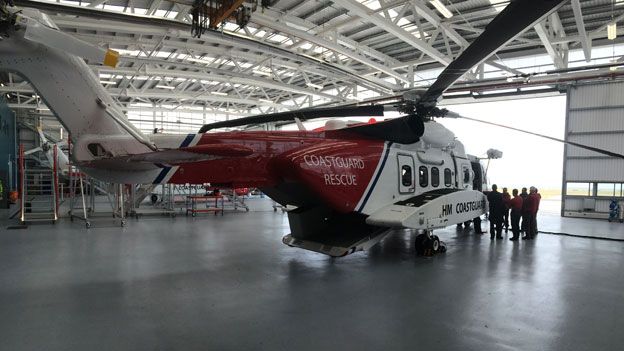Search and rescue moves from RAF Valley to Caernarfon base
- Published

Search and rescue helicopter operations will move from RAF Valley to Caernarfon from Wednesday.
Bristow has a 10-year contract from the Department of Transport to operate from 10 UK bases on behalf of HM Coastguard.
The £1.6bn deal with the new American-owned operators ends 60 years service from the RAF at the Anglesey base.
It is part of a phased switch-over which will also see Bristow operating from St Athan in the Vale of Glamorgan from 1 October.
It is farewell to the RAF Sea Kings over Snowdonia - and hello to search and rescue Sikorsky helicopters
Why the change?
After 60 years of the Royal Air Force, the Royal Navy and the Maritime and Coastal Agency (MCA) taking a role in rescues, in 2005, the Ministry of Defence and Department of Transport decided to set up a single body to deal with search and rescue (SAR) - a mixture of military and civilian.
Their plan for the PFI-funded project was terminated in 2011 and the government announced that the future SAR service would be provided by a fully civilian aircrew. This reflected the military's decision to withdraw from civilian SAR to focus on frontline operations. It also coincided with the retirement of the Sea King helicopters, due in March 2016.
What will the difference be?
Bristow claims people will not see any difference from the service offered by the RAF but some mountaineers and members of mountain rescue teams as well as politicians have concerns. There is a fear that profit for shareholders has to be considered. There may be questions if the helicopters are used too often.
There is concern that this could lead to more pressure on the volunteers of the mountain rescue teams because of the increasing popularity of Snowdon - 600,000 people visited the summit in 2013.
Others say that contracting the SAR service is the thin end of the wedge and in time, the UK may follow other countries in Europe and north America, where people take out insurance or have to pay to be rescued.
However others have argued such fear is misplaced because this is not a privatisation.
Bristow Helicopters insist the crews will be on call 24/7, will be called out in exactly the same way and will be highly trained, just like the RAF, with the service remaining state-controlled.
How many will work at the new Caernarfon airport base?
Each of Bristow's SAR bases will be manned by approximately 30 staff including nine pilots, 10 technical crew (five winchman paramedics and five winchman operators) and nine engineers as well as support staff. The base at Caernarfon cost £7m and as well as having specifically designed hangars for the helicopters the base also has bedrooms for the crews to rest.
Bristow is one of the largest civilian helicopter companies in the world and its SAR fleet has state-of-the-art technology.
Will the helicopters look different?
The biggest change will be in the livery of the RAF helicopters.
The RAF Sea Kings were bright yellow and used to be known locally as the "yellow budgies" but the Bristow helicopters are red and white.
What will happen to the RAF crews from Valley now?
RAF Valley on Anglesey will continue, mainly as the centre for training fighter jet pilots. Some SAR presence will be retained in Valley for a few months before the whole operation is wound up entirely. Although the private company is taking charge, there will still be a standby crew at RAF Valley in case they are needed whilst the new company gets fully operational.
Samantha Willenbacher, director of UK Search and Rescue at Bristow Helicopters, said: "We know this is a service that people rely on in times of great need and we are committed to continuing the great work of the military."
A new hangar is being built at the St Athan Aerospace Business Park to house the two search and rescue helicopters from this autumn.
It will become the first south-Wales search and rescue base since the end of operations at RAF Brawdy in Pembrokeshire in 1994.
- Published17 May 2015
- Published9 January 2014
- Published26 March 2013
- Published26 March 2013